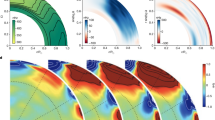Abstract
IT has been recognized since the time of the Argus experiments1,2 that the anomalously low value of the Earth's total magnetic field in the South Atlantic region must have a profound effect on the particles trapped in the radiation belts. The most convincing illustrations of this are the counting-rates of charged particles observed at relatively low altitudes with the Russian cosmic ships3,4 and recent American satellites in the Discoverer series5. The maps prepared by both groups show two regions of high radiation intensity in the area of the South Atlantic Ocean, at heights of 250–500 km, where the counting-rates exceed those at corresponding geomagnetic latitudes elsewhere by factors of the order of 1,000 or more. One of these regions, coinciding well with the centre of the magnetic anomaly off the coast of Brazil, is attributed to the inner radiation belt. The other, referred to as the ‘south radiation anomaly’, lying between Cape Town and Antarctica, is thought to be due to the outer belt. These assignments are supported by the observation that the Argus belts of particles lay in the region between the two natural radiation belts1, corresponding to the positions of the detonation sites between the two recently discovered anomalous radiation zones.
This is a preview of subscription content, access via your institution
Access options
Subscribe to this journal
Receive 51 print issues and online access
$199.00 per year
only $3.90 per issue
Buy this article
- Purchase on Springer Link
- Instant access to full article PDF
Prices may be subject to local taxes which are calculated during checkout
Similar content being viewed by others
References
Christofilos, N. C., J. Geophys. Res., 64, 869 (1959).
Welch, J. A., and Whitaker, W. A., J. Geophys. Res., 64, 909 (1959).
Ginzburg, V. L., Kurnosova, L. V., Logachev, V. I., Razorenov, L. A., and Fradkin, M. I., J. Phys. Soc. Japan, 17, Supp. A II, 128 (1962).
Kurnosova, L. V., Kolobyanina, T. N., Logachev, V. I., Razorenov, L. A., Sirotkin, I. A., and Fradkin, M. I., Planet. Space Sci., 9, 513 (1962).
Seward, F. D. (private communication).
Vestine, E. H., and Sibley, W. L., J. Geophys. Res., 65, 1967 (1960).
O'Brien, B. J., Laughlin, C. D., Van Allen, J. A., and Frank, L. A., J. Geophys. Res., 67, 1209 (1962).
O'Brien, B. J., J. Geophys. Res., 67, 1227 (1962).
Hoffman, R. A., J. Geophys. Res., 66, 4003 (1961).
Cladis, J. B., and Dessler, A. J., J. Geophys. Res., 66, 343 (1961).
McIlwain, C. E., J. Geophys. Res., 65, 2727 (1960).
Nakamura, J., Rep. Ionosph. Res. Japan, 12, 419 (1958).
Sandford, B. P., J. Atmos. Terr. Phys., 24, 155 (1962).
Author information
Authors and Affiliations
Rights and permissions
About this article
Cite this article
GLEDHILL, J., VAN ROOYEN, H. Cape Town Anomaly and Auroral Emission. Nature 196, 973–975 (1962). https://doi.org/10.1038/196973b0
Issue Date:
DOI: https://doi.org/10.1038/196973b0
Comments
By submitting a comment you agree to abide by our Terms and Community Guidelines. If you find something abusive or that does not comply with our terms or guidelines please flag it as inappropriate.



